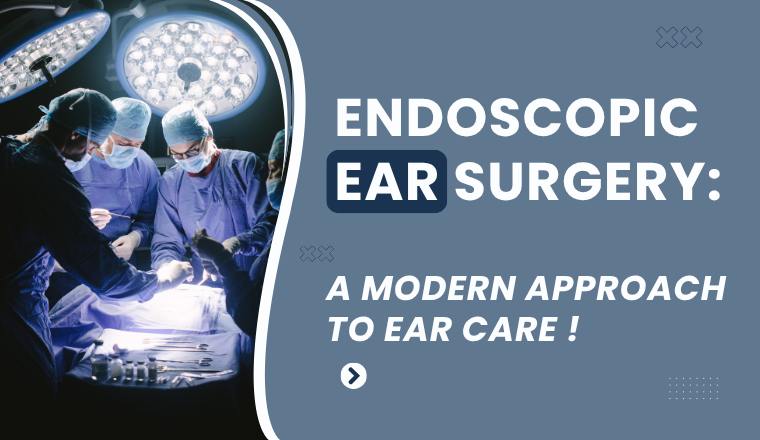Ear conditions, ranging from chronic infections to hearing loss, often require surgical treatment when medications or non-invasive therapies fail. Traditionally, ear surgeries were performed using microscopes and larger incisions. However, with advances in technology, Endoscopic Ear Surgery (EES) has emerged as a minimally invasive and highly effective alternative.
In this blog, we’ll explore what endoscopic ear surgery is, how it works, who it’s for, and why it’s becoming a preferred technique in modern ENT practice.
What is Endoscopic Ear Surgery?
Endoscopic Ear Surgery is a minimally invasive procedure that uses a thin, rigid tube called an endoscope, equipped with a camera and light, to access and treat conditions inside the ear. Unlike traditional microscopic ear surgery, which often requires a large incision behind the ear, endoscopic surgery is performed through the ear canal, resulting in no visible scars and faster recovery.
This approach provides high-definition, wide-angle views of the middle ear structures, which helps surgeons operate more precisely, especially in hard-to-reach areas.
Common Conditions Treated with Endoscopic Ear Surgery
Endoscopic techniques are being increasingly used for a variety of ear problems, such as:
- Chronic Otitis Media (middle ear infections)
- Cholesteatoma (abnormal skin growth in the middle ear)
- Ossicular chain reconstruction (repairing hearing bones)
- Tympanoplasty (repair of the eardrum)
- Stapedotomy (for otosclerosis and hearing restoration)
Advantages of Endoscopic Ear Surgery
There are several key benefits of endoscopic ear surgery over the traditional microscopic approach:
1. Minimally Invasive
- No large incision behind the ear
- Performed through the natural ear canal
2. Better Visualization
- Endoscopes offer a 360-degree view of the middle ear
- Allows better access to hidden or narrow spaces
3. Faster Recovery
- Less tissue disruption leads to quicker healing
- Reduced post-operative pain and swelling
4. Aesthetic Advantage
- No external scars or visible stitches
5. Improved Precision
- High-definition images allow more accurate treatment, reducing the risk of complications
How is the Procedure Performed?
Endoscopic ear surgery is usually performed under general anesthesia. Here’s a brief overview of the process:
- Insertion of Endoscope: A small endoscope is gently inserted into the ear canal.
- Real-Time Imaging: The surgeon views the internal structures on a monitor.
- Surgical Intervention: Using fine instruments, the necessary repair or removal is performed.
- Closure: Since the surgery is done through the ear canal, minimal or no sutures are needed.
Most procedures are completed within 1–2 hours, and many patients can return home the same day.
Who is a Candidate for Endoscopic Ear Surgery?
You may be a good candidate for endoscopic ear surgery if you:
- Suffer from chronic or recurrent ear infections
- Have a perforated eardrum
- Are diagnosed with cholesteatoma
- Need surgery to improve hearing loss due to ossicle damage
- Prefer a minimally invasive procedure with no visible scarring
Your ENT surgeon will evaluate your condition and determine whether an endoscopic or microscopic approach is more appropriate.
Recovery and Aftercare
After surgery, patients typically experience:
- Mild discomfort or ear fullness for a few days
- Temporary hearing changes as the ear heals
- Need for follow-up visits to monitor healing and remove packing (if used)
Most people can return to work or school within 5–7 days, although complete healing may take a few weeks.
Post-operative care may include:
- Avoiding water entry into the ear
- Refraining from air travel until advised
- Using prescribed ear drops and medications
- Following up with regular ENT check-ups
FAQs About Endoscopic Ear Surgery
1. Is endoscopic ear surgery painful?
No, the procedure is performed under anesthesia, so you won’t feel pain during the surgery. Post-operative pain is generally mild and manageable with medications.
2. How long does it take to recover from endoscopic ear surgery?
Initial recovery usually takes about a week, but complete healing of the ear can take up to 4–6 weeks depending on the procedure.
3. Is endoscopic surgery better than traditional ear surgery?
For many cases, yes. It offers better visualization, minimal scarring, and faster recovery. However, some complex cases may still require traditional approaches.
4. Are there any risks or complications?
As with any surgery, risks include infection, bleeding, or hearing changes. However, endoscopic techniques tend to reduce these risks due to better precision and minimal tissue damage.
5. Can children undergo endoscopic ear surgery?
Yes, endoscopic ear surgery is safe for children, especially for conditions like chronic ear infections or eardrum repair. Your ENT specialist will determine the best option based on the child’s needs.
